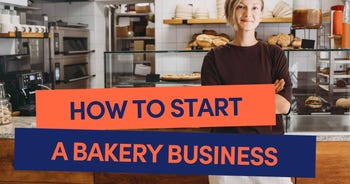Order fulfilment: How to have excellent order fulfilment for your small business
Having a streamlined order fulfilment process plays a big role in the success of your business. With eCommerce growing more than ever, customers are expecting a faster and more efficient post-purchase experience, so it’s vital that you meet — and exceed — their expectations.
But, what exactly is order fulfilment and how can you ensure your customers are satisfied with their shopping experience?
To help you level up your business’s efficiency, our handy guide will walk you through everything you need to know about why and how to boost your order fulfilment process.
What is order fulfilment?
Order fulfilment means ensuring that an order is received, dispatched, and distributed to the customer as per their specifications. As the whole process is made up of a series of individual steps, each stage must be refined so that the whole process runs smoothly.
While fast fulfilment is one of the most important aspects to prioritise, businesses also need to fulfil orders correctly.
When order fulfilment is carried out efficiently, businesses can benefit from reduced running costs, higher customer satisfaction, and a stronger brand reputation.

What does it mean when an order is in fulfilment?
When an order is in fulfilment, it means that it’s going through one of the steps required to deliver the product to the customer.
The steps can range from business to business, but it can be anything from receiving the order, picking the products, packing, dispatching, and delivering. An order going through fulfilment is passing through each of the stages as it makes its way to the customer.
Why is order fulfilment important?
In any type of SME, whether it’s a brick-and-mortar store or an online website, a company needs to fulfil its customers’ orders according to their preferences to create a satisfying shopping experience. If a business is at the point of a sale, they have already attracted and converted a customer, so order fulfilment is important for guaranteeing that the earlier steps don’t go to waste.
As well as fulfilling a sale and giving customers what they’ve paid for, order fulfilment is important because it can help businesses to understand and manage their stock levels. This enables them to meet demand and adjust their stock replenishment based on consumption data. Learn more about how to implement a top stock management strategy with our handy guide.
Also, customers who have a positive experience receiving their order are more likely to buy from a brand again, spread the word about a brand’s service to new customers, and leave positive reviews — all of which contribute to the growth and success of a business.
Why is the order fulfilment process important to eCommerce?
In a physical store, it’s easier for a business to see how much inventory they have and they can manage the entire fulfilment process to mitigate any issues.
With an eCommerce store, it can be more difficult to manage stock if it’s being passed through different departments by several staff members. Essentially, the more steps and hands that an order goes through, the higher the chances of something possibly going wrong. This can also make it more difficult to track an issue and find out at which stage it initially occurred.
That’s why having an excellent order fulfilment process is even more important for eCommerce brands.
How do you choose an order fulfilment strategy?
Not all businesses operate the same way and many will have varying steps that need to be taken into account when processing and delivering orders. That’s why it’s important to choose an order fulfilment strategy that suits your business’s needs and operation process. The four order fulfilment models are:
In-house
The in-house model is when a business completes all the steps in their order fulfilment process internally, with no external parties involved to support at any stage. The business’s employees will handle everything from storage and order preparation to packaging and shipment.
Many start-up businesses will initially operate on an in-house model as it has a relatively lower cost compared to other strategies, especially if they have smaller order volumes. The in-house model is also ideal for large-scale and established companies who want to have full control over all aspects of order fulfilment.
Third-party
The third-party model is the opposite of in-house: the majority, if not all, steps of order fulfilment are carried out by an external operator or another third-party source.
This is the most efficient option for growing businesses that don’t have the space to store all their stock or hire enough staff to fulfil the orders. Instead, the third-party source can perform all the necessary steps to a high standard, while also holding all of a business’s inventory.
Drop shipping
Drop shipping uses a similar process to the third-party model where an external company will handle the order fulfilment for a business – except the external company is often the manufacturer, which means that there’s no inventory for the business to manage.
When the business makes a sale, it will purchase the stock from the manufacturer, who will then handle the rest of the order fulfilment process.
It’s an incredibly efficient strategy for startup and eCommerce businesses as they can benefit from lower overhead costs and they will only pay for products that they have already sold. This guarantees that they won’t have to suffer from over or under-stocking issues.
The drawback to drop shipping is that businesses may have less control over the order fulfilment process as it’s all done by the manufacturer. The manufacturer may also operate in a different country to the business, meaning that shipping times can be longer.
Hybrid
A hybrid fulfilment model is when a business uses a mixture of in-house, third-party, and drop shipping processes.
For example, a business may want to keep everything in-house during quieter seasons, but then they might outsource to a third-party company in peak periods like Christmas. And finally, they might choose to drop ship larger items that they can’t store in their own warehouse directly from the manufacturer.
What are the six steps in the order fulfilment process?
1. Inspecting inventory
The first step starts with your inventory. After receiving your stock from your supplier, you should always check each shipment to make sure that everything is inspected and accounted for.
On the off-chance that there has been a mistake with your inventory, you should report it to your supplier immediately.
2. Warehouse and storage
Once you know that you’ve got the correct amount of stock, it needs to be inventoried and stored in a way so that you can keep track of stock levels.
It might even be distributed to a short or long-term storage facility. Wherever you choose to store your stock, using an inventory management system will give you an idea of stock availability.
3. Picking and processing
Some warehouses will have employees manually selecting each item, but others — like Amazon — may use automated warehouse robots instead.
The products are picked according to a packing slip that has details of a customer’s order. These details may include:
- SKUs
- Product colour
- Size
- Quantity
- Location in the warehouse
4. Packing
After all the items in an order have been collected, they will need to be packaged to keep the goods protected when being shipped. There are two key things to consider when packaging your orders: branding and efficiency.
Your packaging will be your first physical touch-point with your customer, so you’ll want to make a great first impression. It goes without saying that sending the correct products is a must, but you also need to make sure that they’re securely packaged to prevent damage when in transit. Having branded packaging that’s aesthetically pleasing can also help to boost your brand’s image.
Picking the right packaging can benefit you as a business too. Finding a balance of protective but lightweight packaging can help to lower the cost of delivery. Using compact parcels is also recommended as it means delivery trucks will be able to carry more orders when shipping them out – potentially reducing your shipment fees.
5. Shipping
The majority of businesses will use a third-party courier service to ship their products out, so it’s crucial to choose one with a reputable service. You’re essentially handing over part of your order fulfilment to another service provider, so you’ll want to pick one that you can trust to perform the job at an excellent standard.
Unreliable couriers can potentially harm your brand’s image if customers have a bad experience with them.
6. Returns management and after-sales care
Order fulfilment isn’t complete once your customer has received their order. While you should always aim to deliver quality goods on time, there’s always the chance that they’re not fully satisfied. In this instance, customers may wish to return or exchange an item and these services should be treated like any other step in the fulfilment process.
Sometimes, you might receive a quality complaint from a customer regarding their order. The best way to resolve this issue is to offer quick and effective customer service to replace the item in question. If you don’t, you risk your customer having a negative experience and losing their custom in the future.
What makes order fulfilment difficult?
Order fulfilment requires a lot of careful planning to make sure that all the various steps are carried out quickly and accurately. This becomes more difficult when there are more steps and third parties involved. Some of the biggest challenges to overcome when successfully fulfilling orders are:
Inventory control
Not optimising your inventory can have a knock-on effect that damages your business’s success.
Under-stocking, when you run out of inventory, is likely to lead to fewer orders and therefore customers. But overstocking could mean that you’re left with surplus inventory that you struggle to shift — which, again, can put you at a loss. Finding the perfect balance of the optimal inventory to meet the demand of your customers is key to running a successful order fulfilment strategy.
Logistics planning
Even if you have an excellent inventory management system in place, it’ll go to waste if your packaging and distribution stages aren’t up to scratch. Orders should always be fulfilled as soon as possible and they need to be delivered in a good condition by your courier. Delayed and damaged orders are likely to result in dissatisfied customers.
Supply chain management
Even with careful planning and accounting for various issues that may occur, it’s almost impossible to predict when there’ll be an unexpected surge in demand. Having a strong relationship with a trustworthy supplier gives you the best chance of fulfilling sudden rises in orders.
What is the order fulfilment rate?
The order fulfilment rate is the total number of orders processed divided by the total amount of orders you’ve received. It’s a percentage measurement that gives you an indication of how efficiently your business is fulfilling orders. It’s also known as the order fill rate. As a business, you want your order fulfilment rate to be as close to 100% as possible.
How do you choose an order fulfilment process?
Choosing the right order fulfilment process will be different for each type of business. Start by selecting an order fulfilment strategy that best suits the size and complexity of your business.
In-house is best if your company is still in its infancy and you don’t have a lot of stages in your fulfilment process. Third-party is recommended for quickly expanding businesses that want to invest their time into other areas to drive their growth instead of spending it all on fulfilment.
To find something that works for you, consider:
- How many orders do you expect to fulfil?
- How much inventory do you have?
- Do you have enough resources to carry out all the steps in the order fulfilment process?
- How much time do you have to invest in order fulfilment?
- How much control do you want over your order fulfilment?
How do I keep up my order metrics?
As well as monitoring your order fulfilment rate, there are a few other metrics that you can use to understand how effective your process is. Analysing these will be able to give you insight into which steps are working well and which ones could be improved to boost your efficiency and customer satisfaction.
A few metrics to think about are:
- Percentage of on-time shipments – This is the number of orders dispatched on time or ahead of the estimated shipping date, compared against the complete amount of orders shipped.
- Average delivery lead time – This refers to the amount of time it takes for an order to reach the customer. For in-house strategies, it might be measured from the moment an order is placed, up to the confirmation that it’s been received by the customer. Other methods may track the order confirmation up to the date that it’s been shipped by a third-party delivery provider.
- Fulfilment cost per order – This is a measurement of how much your business spends to fulfil an order from start to finish. An accurate result should take into account things like employee labour, communication, inventory management costs, and shipping fees.
- Order error rates – This is an indicator of how many orders are fulfilled wrong or incorrectly, compared to the total number of orders fulfilled within a given time frame. A lower error rate is a sign that your order fulfilment process is working successfully.
- Inventory turnover – Inventory turnover can be calculated by dividing the total cost of your orders by your average inventory level. It’ll give you an idea of demand and how well your business is doing at meeting it via your inventory replenishment strategy.
Choosing the right order fulfilment strategy to suit your business
Having a smooth and reliable order fulfilment strategy can mean the difference between whether your business succeeds or struggles in satisfying your customers’ needs. This guide should have helped you work out a process that works for your business so it can complete sales and achieve a high customer satisfaction level.
We have a range of guides that can help make running your business a bit easier, and our tech-enabled team can help cut down on annoying business admin. We can help with all your business essentials, including business energy, insurance, phone and broadband.







